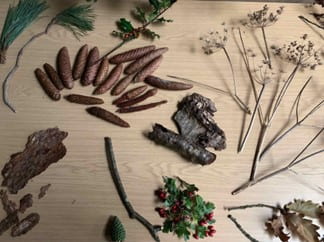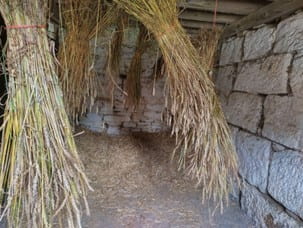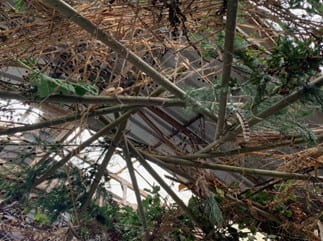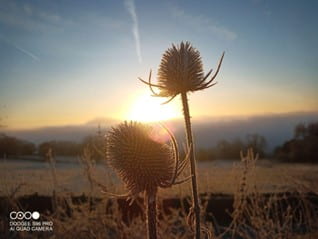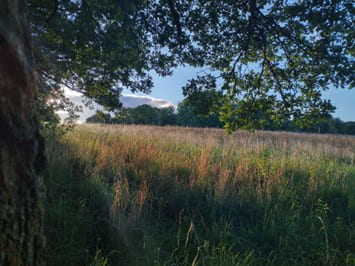We set out in our project to better understand the process of relearning interdependence between landscape and community. Something all those involved in the project believed had been seriously degraded if not lost through rhetoric the separation that has seeped through all of our lives, our culture and world views.
I saw this question as one that asked many questions; what does it mean to feel and behave as intrinsically part of the world around us. What does it mean to ask this question? How does it feel to attempt to answer this question? What does learning even mean in this context? The list goes on.
We wanted to pose this question not up in the air as a theoretical exercise but upon the ground. A very specific piece of ground in Derbyshire, High Leas Farm. A young and growing land project where the line between human and landscape is intentionally being blurred. At the farm exists a growing community of people from all walks of life, all bound by an exploration of questions such as who we are, where we are and what we are doing.
The Brigstow project was an attempt to bring together this piece of land, the community that exists there and a wider community of people to explore the question “how do we relearn interdependence?”. This writing is my go at sharing some of what we/I learnt along the way.
It would be hard to start anywhere other than language and its role in both integration and separation. Language is the means we have to both understand the world and then create a shared understanding with those around us. Without language the project would have been very difficult to create and experience! However, it consistently tripped us up. Different people attach completely different meanings to the certain symbols we call words. This divergence in perceived meaning can hamper our ability to formulate and share ideas. One sentence can unknowingly pit one person’s view of the world against another’s. What we learnt was that to start to really understand one another, time is needed. Time to unpack words and what they mean. Time to understand one another. Time to develop shared language that allows us to relate to one another and the landscapes we are all innately flowing through. This project gave us a small amount of time, time to begin to develop a shared language and understanding of each other.
There are two sides to the coin of language though. On the other side from separation is language’s ability for us to process and communicate the plethora of emotions and thoughts that pass through us when we approach such a broad and fraught subject as relationship to each other and landscape. When a freedom of words is felt we can harness creativity, connect to our humanness and share a moment. One clear example of this was the poems created by Rowan Hyde during the project. Capturing the essence of their and our experiences in a way that brought us together and built connection.
Flowing from this, I see creativity as a key process in the way in which we as humans relate to each other and the world around us. Through the process of creating something we must delve into ourselves and the world around us and for me this seems important if we are to rebuild a way of relating to the world around us.
Creativity emerged throughout this project, sometimes planned and sometimes not. As we worked with natural materials from the farm to create a hanging mobile that would sit over us as we celebrated the year and each other, something interesting happened. The whole group dynamic shifted, we effortlessly slid between time alone working closely with the material we chose and time together. In this time together we found a shared rhythm and sense of task. Out of this slipping between self, group and task emerged song. We sang as we wove and personally I felt more connected to the group and place in that hour of craft and song that I had through the whole year. There is a lot in this and I can’t say I fully understand what it is. My best guess is that shared making is a state in which we lose the heightened sense of individuality that is born from a modern view of separation. It is a state in which we see connection not divide.
Through singing together we shared history with those who wrote the words, we shared time with those we were sharing/attempting to share rhythm with and we shared space with each other as we bent the air around us.
Through craft we build connection with the world around us. Working with live and animate materials we had to understand them. We had to feel what it is like to hold them, feel how they respond to us and then respond to them. We had to meet them as they were and learn about them. Although we know so little about the living world around us, craft gives us a lens to learn. The resistance or response we feel from a material tells us about the life that material lives. It tells us of how and why it grows, it tells us about that individual and its passage through time. The life of the material meets the life of the person and what is created is an amalgamation of the two. It is neither a human or non human artefact, it is a realisation of life. As we learnt with these materials and built connections to them we shared our experiences with each other. Slowly weaving together stories.
I have to admit I hadn’t thought deeply about stories before this process. I appreciated their importance in bringing us together through time and space but I would be lying if I said I had fully appreciated their role in who we are and who we may become. Stories helped us meet one another through telling our own stories. They helped us explore the peripheries of ourselves and the way we see the world. They helped us explore the landscapes we shared, picking up old stories of place, people and practice. They helped us imagine new futures.
I feel this might be what came of this first tiny step into exploring such a massive question. To start to relearn relationship to the world around us is to find and treasure that which remains in our cultures that fosters connections. Our words, our poems, our songs, our crafts and our stories. These are all means of connection we still hold and gifted to us from our past.
